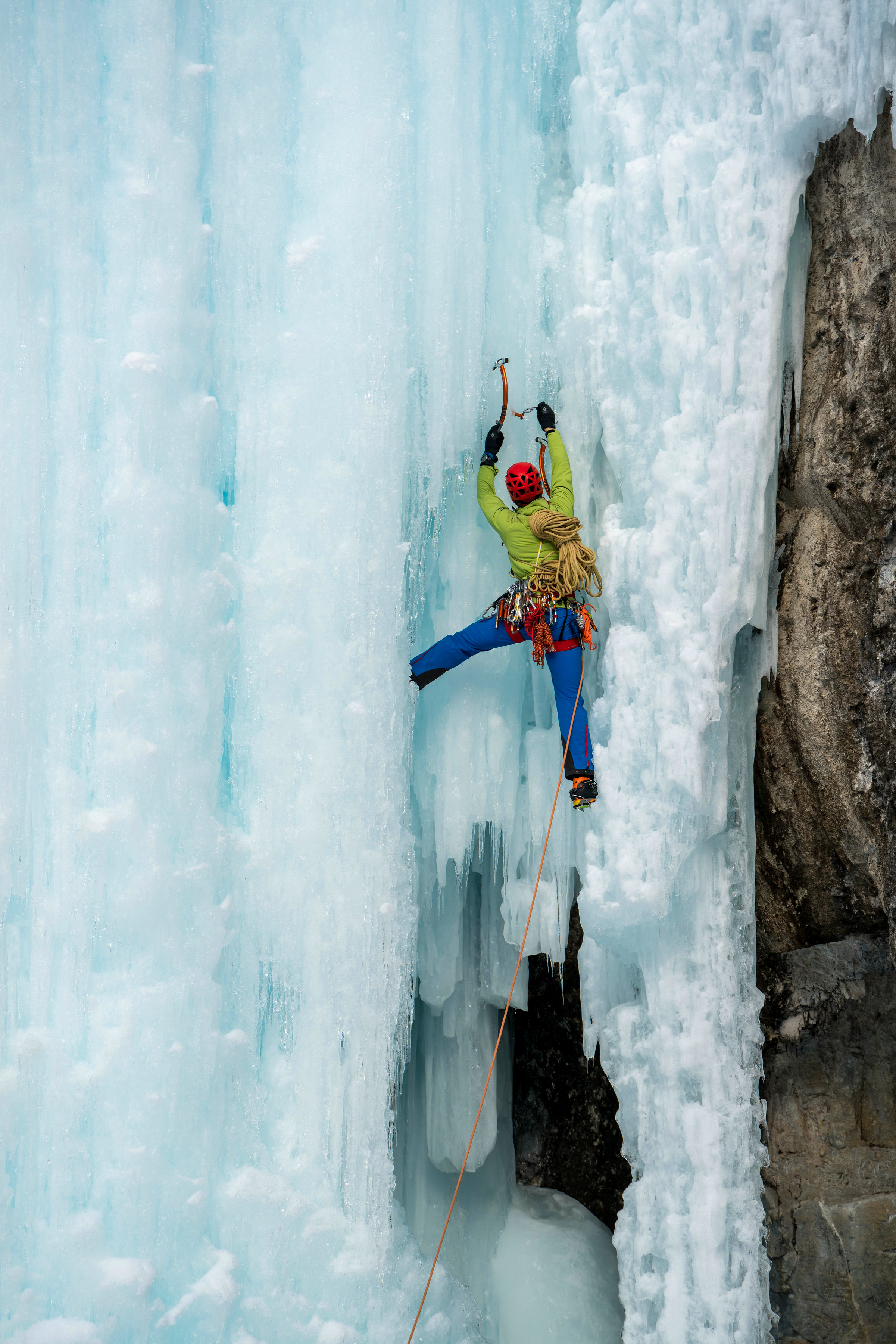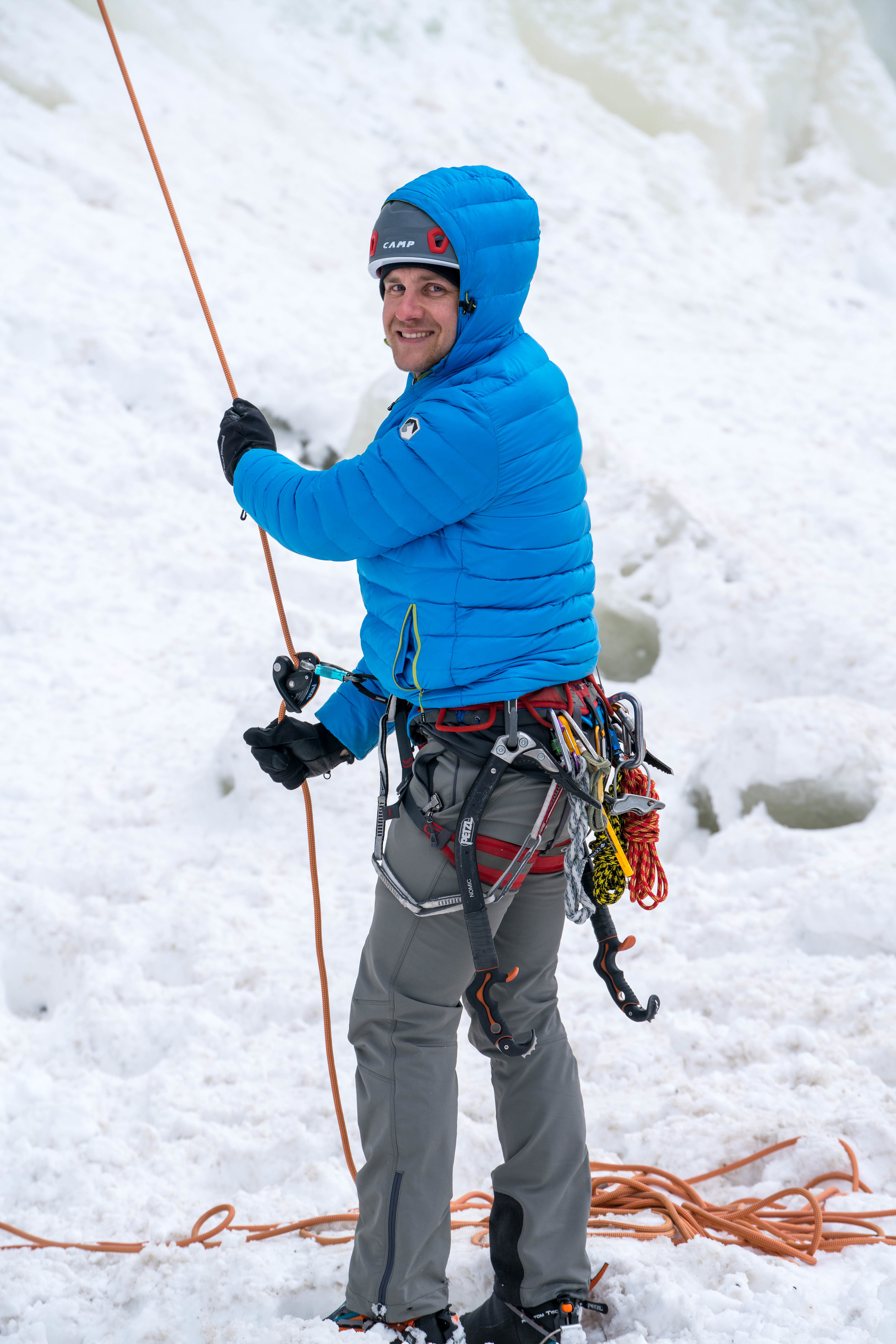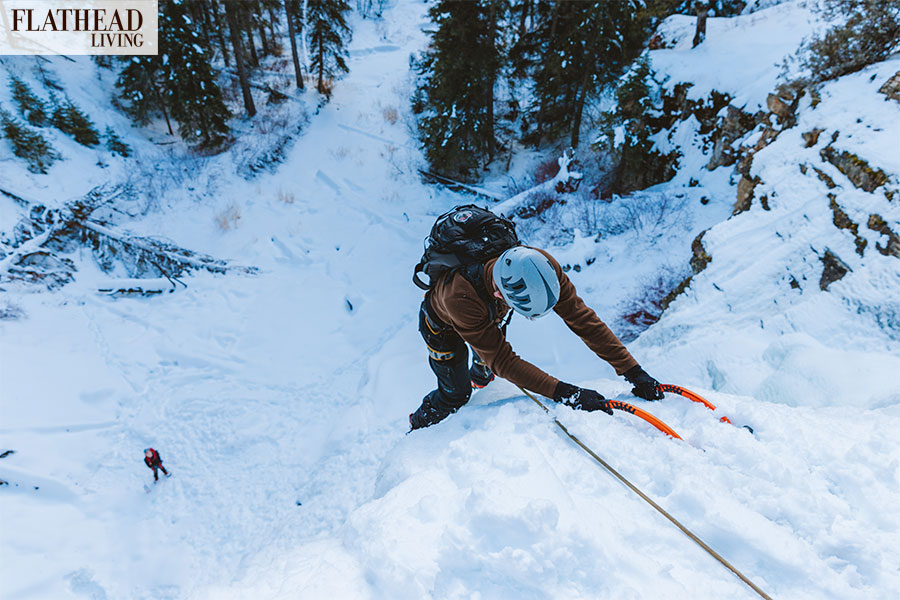In winter, the flat waters of Northwest Montana solidify and become quiet. But gravity keeps some currents alive. Wherever cold water drips off cliffs and ledges, dramatic sculptures of ice form — not unlike stalagmites and stalactites. When this happens, people like Joel Anderson ascend the formations.
Last winter, Anderson, an American Mountain Guides Association (AMGA) certified single pitch instructor, launched Whitefish Vertical Adventures, Northwest Montana’s newest ice climbing guide service.
“It’s a cool niche he’s going after,” says Billy O’Donnell, a professional mountain athlete and founder of RIDGE Mountain Academy, the Whitefish gap-year program where Anderson coached students in skiing, climbing, and more. “He’s accomplished [as an athlete] and strong. He’s also very open. He has a soft approachability; he doesn’t have a rough edge.”
Anderson had been thinking about perhaps buying an existing mountain guiding business, but instead he worked with RIDGE to begin building up his equipment base. Anderson’s local climbing partners, like John Gangemi, also encouraged him to take the leap.
“He’s very calm, always there to support you,” Gangemi says. “He’ll step right up, but he’s not domineering. He doesn’t have the ego … he’s very thorough and conscious about what’s going on around him, safety-oriented. He doesn’t take risks — he eliminates risks with systems.”
Anderson grew up in Lewiston, Idaho, on the Washington border, at the confluence of the Snake and Clearwater Rivers. He found his way into seasonal outdoors-focused careers, spending time in Whitefish as well as Idaho and Oregon. During summers, he now works as a mission-planning liaison between the U.S. Forest Service and a helicopter company contracted to supply aircrafts on wildfires. In the winter of 2017, he joined the coaching staff at RIDGE.

Anderson had learned to climb rock in a Boise gym, as well as at Stone Hill, Northwest Montana’s preeminent climbing zone, which overlooks Lake Koocanusa outside Eureka. With YouTube and books as his guides, he taught himself technique, and progressed his skills. Eventually, ice climbing caught his attention.
“In Montana, it’s really hard to climb rock year-round,” Anderson says. “It’s always been pretty appealing to me, being able to scale these vertical waterfalls.”
In 2014, Anderson took a clinic at the Bozeman Ice Festival, a longstanding annual gathering now hosted by the Ice Climbing Alliance. Back home in the Flathead Valley, he applied his new skills on the ice, mostly learning through trial and error in the classic tradition of Montana ice climbing.
In the late 1960s, climbers Chad Chadwick and Wally Hunter, out of Billings, had been using iron crampons from World War II to ascend icy gullies, as David Vaughn writes in Ron Brunchorst’s Big Sky Ice guidebook. The gear they used was better suited for traversing glaciers and steep snow — the only way up a vertical face of ice would have been to chop individual steps. Then Patagonia founder Yvon Chouinard introduced new styles of crampons and axes that made ice climbing a viable sport. Climbers in Billings, Butte, and Bozeman began experimenting with the new gear, which enabled them to ascend steeper terrain than ever before.
“What is remarkable about waterfall ice is that it is ephemeral, hard, and beautiful,” Dougal McCarty writes in Big Sky Ice. “Climbing it is foreign to everyday life, and is special because of it. Every time the climb melts and forms, there is new beauty and a first ascent to do all over again. And if you go a little further into the backcountry, you can find a gem that has never been climbed.”
When an article in a 1971 issue of the Alpine American Journal introduced ice climbing to the masses, “most Montana ice climbers were surprised to find that they were at the forefront of the ‘ice age,’” Vaughn writes. By then, Bozeman-based climber Pat Callis was a “true master of ice climbing of that era,” perfecting the techniques still in use today.
“Early on, the Montana climbers cultivated a hearty tradition modeled after the Scottish heroes of the infamous Creagh Dhu climbing club,” McCarty writes. “Members of one of the first Montana climbing clubs, the Wool Socks, made some of the first efforts at climbing these frozen waterfalls … It became clear that you could climb a lot of things if you were good and bold enough, or just bold.”

Today, Montana’s ice climbing community is concentrated in the southwest, thanks to a great density of routes in zones like Hyalite Canyon, just outside of Bozeman, where Anderson’s clinic was. There are fewer accessible ice formations in Northwest Montana, and a smaller community of climbers, but Anderson was still able to find partners and hone his skills here. From rock climbing, he knew how to set up a top rope and anchor himself securely so he could fall without really falling. It took him about three seasons of dedicated work to feel comfortable leading a climb. “You learn to read the ice,” he says.
“The thought of swinging sharp tools around and sticking them into ice can be intimidating at first,” Anderson says. “Part of why I wanted to get into my business is I wanted to show people it’s not that scary. We’re fortunate enough in the Flathead Valley to have some good, easy beginner places to learn.”
Last winter, Anderson took out 10 paid groups in five weeks — the ice conditions didn’t entirely shape up for a long season. Still, he guided a full range of folks, from first-timers to experienced climbers who hired Anderson to show them the area.
Anderson frequently guides at Stone Hill, which can have ice routes as long as 90 feet, and there are also opportunities for mixed climbing on ice and rock. Bad Rock Canyon, which offers shorter climbs close to town, is a lower-commitment option that’s ideal for beginners. Near Marion, Serenity Falls is a “tranquil spot” that has a short 20-foot waterfall for beginners, and the option to rappel down into a longer, 60 to 70-foot waterfall.
Conditions are dependent on weather, and clients can book half- and full-day trips at various locations around Northwest Montana. Visit www.whitefishvertical.com for more information.
Read more of our best long-form journalism in Flathead Living. Pick up the winter edition for free on newsstands across the valley, or check it out online at flatheadliving.com.
